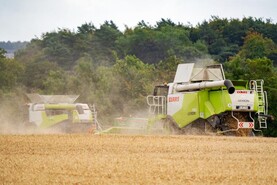With milk price cuts already affecting farm finances, there is little room for dairy farmers to be complacent with cashflow management this year.
Despite recent improvements in dairy markets and indications that the effect of COVID-19 on milk prices might not be as bad as first feared, it is still best to prepare for all eventualities.
The first and most important step is to get a thorough understanding of the farm’s financial position through a cashflow budget. This will allow for informed decision-making on cash management over the coming months.
It also means that conversations with banks can happen early on, especially if measures such as overdraft extensions or temporarily moving to interest-only loan repayments are required.
Feed costs
Controlling feed costs over the coming months will be an effective way of making financial savings. For example, Dairylink farmer James King saved over £10,000 on his meal bill last year by lowering his feed rate from 0.40kg/l to 0.36kg/l.
James achieved this by getting more better-quality grass into cows’ diets during the grazing season, as well as improving herd fertility so cows responded better to concentrates.
Now is the time to capitalise on grazed grass. Dairylink farmers are closely monitoring yields and concentrate feed rates to get as much milk from grazed grass as possible. The aim during May is to get maintenance plus 20 litres from grass.
Read more in this week’s Irish Farmers Journal and at www.ifj.ie/dairylink.
Read more
Dairylink: early first cut on Dairylink farms
Dairylink podcast: achieving efficient feeding
With milk price cuts already affecting farm finances, there is little room for dairy farmers to be complacent with cashflow management this year.
Despite recent improvements in dairy markets and indications that the effect of COVID-19 on milk prices might not be as bad as first feared, it is still best to prepare for all eventualities.
The first and most important step is to get a thorough understanding of the farm’s financial position through a cashflow budget. This will allow for informed decision-making on cash management over the coming months.
It also means that conversations with banks can happen early on, especially if measures such as overdraft extensions or temporarily moving to interest-only loan repayments are required.
Feed costs
Controlling feed costs over the coming months will be an effective way of making financial savings. For example, Dairylink farmer James King saved over £10,000 on his meal bill last year by lowering his feed rate from 0.40kg/l to 0.36kg/l.
James achieved this by getting more better-quality grass into cows’ diets during the grazing season, as well as improving herd fertility so cows responded better to concentrates.
Now is the time to capitalise on grazed grass. Dairylink farmers are closely monitoring yields and concentrate feed rates to get as much milk from grazed grass as possible. The aim during May is to get maintenance plus 20 litres from grass.
Read more in this week’s Irish Farmers Journal and at www.ifj.ie/dairylink.
Read more
Dairylink: early first cut on Dairylink farms
Dairylink podcast: achieving efficient feeding






 This is a subscriber-only article
This is a subscriber-only article









SHARING OPTIONS: